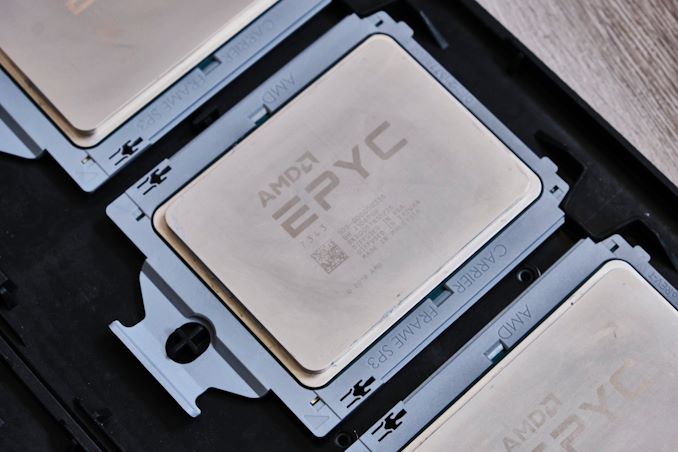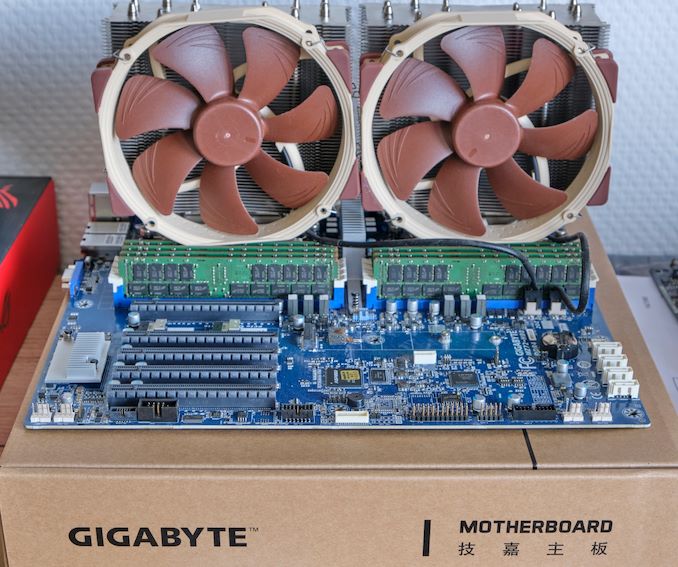AMD EPYC Milan Review Part 2: Testing 8 to 64 Cores in a Production Platform
by Andrei Frumusanu on June 25, 2021 9:30 AM EST
It’s been a few months since AMD first announced their new third generation EPYC Milan server CPU line-up. We had initially reviewed the first SKUS back in March, covering the core density optimised 64-core EPYC 7763, EPYC 7713 and the core-performance optimised 32-core EPYC 75F3. Since then, we’ve ben able to get our hands on several new mid and lower end SKUs in the form of the new 24-core EPYC 7443, the 16-core 7343, as well as the very curious 8-core EPYC 72F3 which we’ll be reviewing today.
What’s also changed since our initial review back in March, is the release of Intel’s newer 3rd generation Xeon Scalable processors (Ice Lake SP) with our review of the 40-core Xeon 8330 and 28-core Xeon 6330.
Today’s review will be focused around the new performance numbers of AMD’s EPYC CPUs, for a more comprehensive platform and architecture overview I highly recommend reading our respective initial reviews which go into more detail of the current server CPU landscape:
-
(April 6th) Intel 3rd Gen Xeon Scalable (Ice Lake SP) Review: Generationally Big, Competitively Small
-
(March 15th) AMD 3rd Gen EPYC Milan Review: A Peak vs Per Core Performance Balance
-
(December 18th) The Ampere Altra Review: 2x 80 Cores Arm Server Performance Monster
What's New: EPYC 7443, 7343, 72F3 Low Core Count SKUs
In terms of new SKUs that we’re testing today, as mentioned, we’ll be looking at AMD new EPYC 7443, 7343 as well as the 72F3, mid- to low core-count SKUs that come at much more affordable price tags compared to the flagship units we had initially reviewed back in March. As part of the new platform switch, we’ll cover in a bit, we’re also re-reviewing the 64-core EPYC 7763 and the 32-core EPYC 75F3 – resulting in a few surprises and resolving some of the issues we’ve identified with 3rd generation Milan in our first review.
| AMD EPYC 7003 Processors Core Performance Optimized |
||||||
| Cores Threads |
Base Freq |
Turbo Freq |
L3 (MB) |
TDP | Price | |
| F-Series | ||||||
| EPYC 75F3 | 32 / 64 | 2950 | 4000 | 256 MB |
280 W | $4860 |
| EPYC 74F3 | 24 / 48 | 3200 | 4000 | 240 W | $2900 | |
| EPYC 73F3 | 16 / 32 | 3500 | 4000 | 240 W | $3521 | |
| EPYC 72F3 | 8 / 16 | 3700 | 4100 | 180 W | $2468 | |
Starting off with probably the weirdest CPU in AMD’s EPYC 7003 line-up, the new 72F3 is quite the speciality part in the form of it being an 8-core server CPU, yet still featuring the maximum available platform capabilities as well as the full 256MB of L3 cache. AMD achieves this by essentially populating the part with 8 chiplet dies with each a full 32MB of L3 cache, but only one core enabled per die. This enables the part (for a server part) relatively high base frequency of 3.7GHz, boosting up to 4.1GHz and landing with a TDP of 180W, with the part costing $2468.
The unit is a quite extreme case of SKU segmentation and focuses on deployments where per-core performance is paramount, or also use-cases where per-core software licenses vastly outweigh the cost of the actual hardware. We’re also re-reviewing the 32-core 75F3 in this core-performance optimised family, featuring up to 32 cores, but going for much higher 280W TDPs.
| AMD EPYC 7003 Processors Core Density Optimized |
||||||
| Cores Threads |
Base Freq |
Turbo Freq |
L3 (MB) |
TDP | Price | |
| EPYC 7763 | 64 / 128 | 2450 | 3400 | 256 MB |
280 W | $7890 |
| EPYC 7713 | 64 / 128 | 2000 | 3675 | 225 W | $7060 | |
| EPYC 7663 | 56 / 112 | 2000 | 3500 | 240 W | $6366 | |
| EPYC 7643 | 48 / 96 | 2300 | 3600 | 225 W | $4995 | |
| P-Series (Single Socket Only) | ||||||
| EPYC 7713P | 64 / 128 | 2000 | 3675 | 256 | 225 W | $5010 |
In the core-density optimised series, we’re continuing on using the 64-core EPYC 7763 flagship SKU which lands in at 280W TDP and a high cost of $7890 MSRP. Unfortunately, we no longer have access to the EPYC 7713 so we couldn’t re-review this part, and benchmark numbers from this SKU in this review will carry forward our older scores, also being aptly labelled as such in our graphs.
| AMD EPYC 7003 Processors | ||||||
| Cores Threads |
Base Freq |
Turbo Freq |
L3 (MB) |
TDP | Price | |
| EPYC 7543 | 32 / 64 | 2800 | 3700 | 256 MB | 225 W | $3761 |
| EPYC 7513 | 32 / 64 | 2600 | 3650 | 128 MB | 200 W | $2840 |
| EPYC 7453 | 28 / 56 | 2750 | 3450 | 64 MB | 225 W | $1570 |
| EPYC 7443 | 24 / 48 | 2850 | 4000 | 128 MB |
200 W | $2010 |
| EPYC 7413 | 24 / 48 | 2650 | 3600 | 180 W | $1825 | |
| EPYC 7343 | 16 / 32 | 3200 | 3900 | 190 W | $1565 | |
| EPYC 7313 | 16 / 32 | 3000 | 3700 | 155 W | $1083 | |
| P-Series (Single Socket Only) | ||||||
| EPYC 7543P | 32 / 64 | 2800 | 3700 | 256 MB | 225 W | $2730 |
| EPYC 7443P | 24 / 48 | 2850 | 4000 | 128 MB | 200 W | $1337 |
| EPYC 7313P | 16 / 32 | 3000 | 3700 | 155 W | $913 | |
Finally, the most interesting parts of today’s evaluation are AMD’s mid- to low-core count EPYC 7443 and EPYC 7343 CPUs. At 24- and 16-core, the chips feature a fraction of the maximum theoretical core counts of the platform, but also come at much more affordable price points. These parts should especially be interesting for deployments that plan on using the platform’s full memory or I/O capabilities, but don’t require the raw processing power of the higher-end parts.
These two parts are also defined by having only 128MB of L3 cache, meaning the chips are running only 4 active chiplets, with respectively only 6 and 4 cores per chiplet active. The TDPs are also more reasonable at 200W and 190W, with also respectively lower pricing of $2010 and $1565.
Following Intel’s 3rd generation Xeon Ice Lake SP and our testing of the Xeon 28-core 6330 which lands in at an MSRP of $1894, it’s here where we’ll be seeing the most interesting performance and value comparison for today’s review.
Test Platform Change - Production Milan Board from GIGABYTE: MZ72-HB0 (rev. 3.0)
In our initial Milan review, we unfortunately had to work with AMD to remotely test newest Milan parts within the company’s local datacentre, as our own Daytona reference server platform encountered an unrecoverable hardware failure.
In general, if possible, we also prefer to test things on production systems as they represent a more mature and representative firmware stack.
A few weeks ago, at Computex, GIGABYTE had revealed their newest revision of the company’s dual-socket EPYC board, the E-ATX MZ72-HB0 rev.3.0, which now comes with out-of-box support for the newest 3rd generation Milan parts (The prior rev.1.0 boards don’t support the new CPUs).
The E-ATX form-factor allows for more test-bench setups and noiseless operation (Thanks to Noctua’s massive NH-U14S TR4-SP3 coolers) in more conventional workstation setups.
The platform change away from AMD’s Daytona reference server to the GIGABYTE system also have some significant impacts in regards to the 3rd generation Milan SKUs’ performance, behaving notably different in terms of power characteristics than what we saw on AMD’s system, allowing the chips to achieve even higher performance than what we had tested and published in our initial review.












58 Comments
View All Comments
eastcoast_pete - Friday, June 25, 2021 - link
Interesting CPUs. Regarding the 72F3, the part for highest per-core performance: Dating myself here, but I recall working with an Oracle DB that was licensed/billed on a per-core or per-thread basis (forgot which one it was). Is that still the case, and what other programs (still) use that licensing approach?And, just to add perspective: the annual payments for that Oracle license dwarfed the price of the CPU it ran on, so yes, such processors can have their place.
flgt - Friday, June 25, 2021 - link
More workstation than server, but companies like Ansys still require additional license packs to go beyond 4 cores with some of their tools, and they often come with hefty 5-figure price tags depending on the program and your organizations bargaining ability.RollingCamel - Friday, June 25, 2021 - link
It was refreshing to see Midas NFX running without core limitations.The core limitations archaic and doesn't represent the current development. Unless the license policies has evolved in the past years.
realbabilu - Monday, June 28, 2021 - link
Interesting to see The fea implementation with latest math kernel available like midas nfx bench in anandtech. Hopefullly anandteam got demos from midas korea for testing. Abaqus, msc nastran, inventor fea anything will do.However i dont think midas improved their math kernel, i had midas civil and gts licensed, but cant use all threads and all memory i had On my pc, like others fea dis.
mrvco - Friday, June 25, 2021 - link
Power unit pricing! LOL, the dreaded Oracle audit when they needed to find a way to make their quarterly numbers!?!?!eek2121 - Friday, June 25, 2021 - link
It blows my mind that people still use Oracle products.Urbanfox - Sunday, June 27, 2021 - link
For a lot of things there isn't a viable alternative. The hotel industry is a great example of this with Opera and Micros.phr3dly - Friday, June 25, 2021 - link
In the EDA world we pay per-process licensing. As with your scenario, the license cost dwarfs the CPU cost, particularly over the 3-year lifespan of a server. You might easily spend 50x the cost of the server on the licenses, depending on the number of cores. Trying to optimize core speed/core count/eventual server load against license cost is a fun optimization problem.So yeah, the CPU cost is irrelevant. I'm happy to pay an extra several thousand dollars for a moderate performance improvement.
eldakka - Saturday, June 26, 2021 - link
> Oracle DB that was licensed/billed on a per-core or per-thread basis (forgot which one it was). Is that still the case, and what other programs (still) use that licensing approach?Lots of Enterprise applications still use that approach, Oracle (not just DB), IBM products - WebSphere Application Server (all flavours, standalone, ND, Liberty, etc.), messaging products like WebSphere MQ, I believe SAP uses it, many RedHat 'middleware' products (e.g. JBOSS web server, EAS, etc.) use it as well.
In the enterprise space, it is basically the expected licensing model.
And the licensing cost per-core is usually 'generation' dependant. So you usually just can't upgrade from, say, a 20-core Xeon 6th-gen to a 20-core 8th gen and expect to pay the same.
The typical model is a 'PVU', Processor Value Unit (different companies may give it a different label - and value different processors differently, but it usually boils down to the same thing). Each platform-generation (as decided by the software vendor, i.e. Oracle, or IBM, etc.) has a certain PVU per core. E.g., (making up numbers here) a POWER8 (2014ish release) might have a PVU of 4000, and an Intel Haswell/Ivy Bridge - E5/7 v2/3 I think (2014/15ish)- might be given 3500. So if using an 8-core P8 LPAR that'd be 32000 PVU, while an 8 core VI on E7 v3 would be 28000. And P9 might be 7000 PVU, a Milan might be 6000 PVU, so for 8-cores it'd be 56000 or 48000 respectively. Then there will be a doller per PVU multiplier based on the software, so software bob could be x1 per year, so in the P9 case $56k/year license, whereas software fred mught be a x4 multiplier, so $224k/year. And yes, there can be instances where software being run on a single server (not even necessarily a beefy server) can be $millions/year licensing. If some piece of software is critical, but low CPU/memory requirements, such as an API-layer running on x86 hardware that allows midrange-based apps to interface directly to mainframe apps, they can charge millions for it even if its only using combined 8-cores across 4 2-core server instances (for HA) - though in this case, where they know it requires tiny resources, they'll switch to a per-instance rather than a per-core pricing model, and charge $500k per instance for example.
The per-core PVU can even change within a generation depending on specific CPU feature sets, e.g. the 2TB per-socket limited Xeon might be 5000 PVU, but the 4TB per-socket SKU of the same generation might be 6000 PVU, just because the vendor thinks "they need lots of memory, therefore they are working on big data sets, well, obviously, that's more money!" they want their tithe.
Oh, and nearly forgot to mention, the PVU can even change depending on whether the software vendor is tring to push their own hardware. IBM might give a 'PVU' discount if you run their IBM products on IBM Power hardware versus another vendors hardware, to try and push Power sales. So even though, in theory, a P9 might be more PVU than a Xeon, but since you are running IBM DB2 on the P9, they'll charge you less money for what is conceptually a higher PVU than on say a Xeon, to nudge you towards IBM hardware. Oracle has been known to do this with their aquired SPARC (Sun)-based hardware too.
eastcoast_pete - Saturday, June 26, 2021 - link
Thanks! I must say that I am glad I don't have to deal with that aspect of computing anymore. I also wonder if people have analyzed just how severely these pricing schemes have blunted or prevented advancements in hardware capabilities?